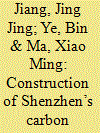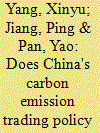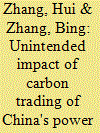|
|
|
Sort Order |
|
|
|
Items / Page
|
|
|
|
|
|
|
| Srl | Item |
| 1 |
ID:
136188


|
|
|
|
|
| Summary/Abstract |
The Shenzhen ETS is the first urban-level “cap-and-trade” carbon emissions trading scheme to operate in China. This paper gives an overview of the economic and emissions situation in Shenzhen and focuses on the development of the Shenzhen ETS regulatory framework. It is devised as an ETS with an intensity-based cap, output-based allocation and a market for trading of allowances. The design of the Shenzhen ETS attaches great importance to coordinate the dynamic relationships between economic growth, industrial transition and emissions control. The cap and its allocation are determined by carbon intensity reduction targets and economic output, with an aim to slow down emissions growth while mitigating shocks from economic fluctuation and industrial adjustment to market stability. The Shenzhen ETS features extensive coverage consisting of three types of regulated entities and four categories of covered emissions, in order to control carbon emissions by both improving energy efficiency and restraining growing energy demand. A competitive game theory method is created for allocation of free allowances to manufacturing enterprises. Mechanisms for carbon offsets and market stabilization are developed to promote active and orderly trading in the carbon market. Moreover, several challenges and their policy choices are detailed for the development of the Shenzhen ETS.
|
|
|
|
|
|
|
|
|
|
|
|
|
|
|
|
| 2 |
ID:
176794


|
|
|
|
|
| Summary/Abstract |
The implementation of China's carbon emission trading policy has targeted achieving emission reduction and environmental protection as well as promoting economic development and technological innovation. The analysis is made through applying the Difference-in-Differences model and using the Ordinary Least Squares method and the Least Square Dummy Variable method in the paper. Results show that the pilot carbon emission trading policy leads to the expansion of employment scales and the reduction of carbon emissions after controlling for the environmental regulation, population size, economic level, and other important variables. Thus, it implies that an employment double dividend exists. For the Porter effect, it is found in the pilot carbon emission trading policy only without adding any control variable. The effect is further verified based on a robustness checks and a placebo test. Furthermore, from the perspective of market-oriented environmental regulation policy, this study explains that the carbon emission trading system launched in 2017 needs to be improved to spread both the employment double dividend and the Porter effect to the whole nation. China also needs to form a complete set of strict ecological environment protection policies and administrative measures to achieve sustainable development of the economy.
|
|
|
|
|
|
|
|
|
|
|
|
|
|
|
|
| 3 |
ID:
177148


|
|
|
|
|
| Summary/Abstract |
Carbon trading is considered a strategy for reallocating carbon permits and reducing abatement costs that may also change energy consumption and the distribution of atmospheric pollution emissions, resulting in environmental health benefits or damage on a regional scale. In this research, we use an agent-based model to construct a national carbon emissions trading market of the power sector based on the year of 2013, and simulate the key atmospheric pollution emission patterns and the corresponding environmental health effects. We find that compared with a command and control policy, the carbon trading policy is able to reduce the CO2 emissions and save abatement costs by approximately 63.53 RMB/ton. Meanwhile, the results show the carbon trading policy would synergistically reduce PM2.5 emissions by 1.55 million tons. Addition, we use a simplified exposure-response model to estimate health benefits by synergistically reducing PM2.5 emissions, and find that the carbon trading policy would decrease 45,200 cases of all-cause mortality and generate 307.07 billion RMB in environmental health benefits. The co-benefit accounts for 0.52% of the nation's gross domestic product (GDP) in 2013. However, compared with the command and control policy, carbon trading changes the pollution emission distribution among the different provinces, and results in unintended environmental health damages in some provinces. Setting reasonable trading directions and exchange ratios, increasing stringency of environmental regulations in some provinces with worsening air pollution should be implemented to complement the carbon trading policy.
|
|
|
|
|
|
|
|
|
|
|
|
|
|
|
|
|
|
|
|
|